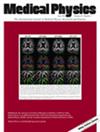Analysis of quantitative angiography in intracranial aneurysm using projection foreshortening correction and injection bias removal
Abstract
Background
In neurovascular disease applications, 2D quantitative angiography (QA) based on digital subtraction angiography (DSA), is an intraoperative methodology used to assess disease severity and guide treatment. However, despite DSA's ability to produce detailed 2D projection images, the inherent dynamic 3D nature of blood flow and its temporal aspects can distort key hemodynamic parameters when reduced to 2D. This distortion is primarily due to biases such as projection-induced foreshortening and variability from manual contrast injection.
Purpose
This study aims to mitigate these biases and enhance QA analysis by applying a path-length correction (PLC) correction, followed by singular value decomposition (SVD)-based deconvolution, to angiograms obtained through both in-silico and in-vitro methods.
Methods
We utilized DSA data from in-silico and in-vitro patient-specific intracranial aneurysm models. To remove projection bias, PLC for various views were developed by co-registering the pre-existing 3D vascular geometry mask with the DSA projections, followed by ray tracing to determine paths across 3D vessel structures. These maps were used to normalize the logarithmic angiographic images, correcting for projection-induced foreshortening across different angles. Subsequently, we focused on eliminating injection bias by analyzing the corrected angiograms under varied projection views, injection rates, and flow conditions. Regions of interest at the aneurysm dome and inlet were placed to extract time density curves for the lesion and the arterial input function, respectively. Using three standard SVD methodologies, we extracted the aneurysm impulse response function (IRF) and its associated parameters peak height (PHIRF), area under the curve (AUCIRF), and mean transit time (MTT). The effectiveness of PLC and SVD in eliminating injection bias is assessed by examining the slope of MTT versus injection duration.
Results
Our findings revealed that projection and injection parameters significantly affect key quantitative angiographic parameters such as PHIRF, AUCIRF, and MTT. Our approach utilizing PLC followed by SVD-based deconvolution consistently reduced these effects from a slope of 0.363 ± 0.179–0.015 ± 0.017 across in-silico and from 0.842 ± 0.07–0.031 ± 0.015 in-vitro settings, yielding stable and reliable measurements which were correlated only with the hemodynamic conditions.
Conclusion
Our methodology employing PLC and SVD-based deconvolution ensures reliable quantitative angiographic measurements across varying conditions, supporting consistent assessments of disease severity and treatment efficacy. This approach enhances intrapatient and intraprocedural reliability in neurovascular diagnostics.

 求助内容:
求助内容: 应助结果提醒方式:
应助结果提醒方式:


